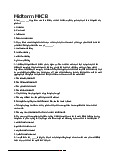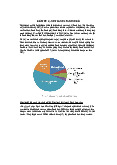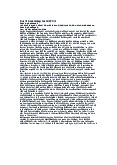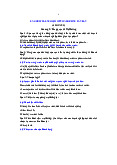



















Preview text:
Draft (December 2015) Inner Melbourne Action Plan 2015-2025 [Page intenonally le blank]
P a g e | 2 Inner Melbourne Acon Plan –December 2015 (Dra Plan for Consultaon) Preamble
“The map of our urban futures is a source of optimism and anxiety, excitement and reecon, vision
and uncertainty. As this century of cities evolves, the essenal requirements of city competiveness,
those of growth, skills, enterprise and trade have now been coupled with the need for sustainability,
resilience and liveability; transparency and governance; innovaon, culture, disncveness, and
adaptability, amongst the many more qualies that we demand of the city in order to shelter,
entertain, inspire and encourage us. a
The ability of cities to aract investment, manage their growth, and deliver quality of life will dene
the character and ulmately the success of the ‘metropolitan century’. b
Rosemary Feenan, Head of Global Research Programmes a, JLL Cies Research
Centre; and Greg Clark, Chairman b: The Business of Cies 2015
Melbourne – a liveable city
Liveability, in its broadest sense, refers to the sum of the factors that add up to a community’s ‘quality of life’.
Liveable communies are regarded as safe, aractive, socially cohesive and inclusive, and environmentally
sustainable, with aordable and diverse housing linked via public transport, walking, and cycling to
employment, education, public open space, local shops, health and community services, and leisure and 1
cultural opportunities.
For some years, Melbourne has remained at or near the top of the globally signicant league table of ‘world’s
most liveable cies’. 2 It is clear that Melbourne’s liveability starts from a high base, and undoubtedly has
exemplary characteriscs and investments that realise ‘liveable city’ aributes. However, it cannot support
liveability in the longer term while it remains one of the world’s highest CO2 emiers per capita. All ers of
government, corporaons and the private sector have a denive responsibility to support iniaves to deliver a low carbon society.
The challenge for the inner Melbourne region is to maintain the liveability whilst accommodang high levels of
growth. The Inner Melbourne Councils need to collaborate to both ancipate and respond to the changes that
lie ahead. Managing the delivery of physical, social and environmental infrastructure for inner Melbourne
under increasing growth and demographic change requires new and innovave models which maximise
eciencies in land use, design and cost of services, and respond to changing community expectaons.
Respecng Inner Melbourne’s established urban structure and character
Melbourne is a constantly evolving city. New enterprises, transformave land uses, emerging technologies,
and incremental urban renewal are reshaping substantial areas across the inner city.
Twenty-rst-century inner Melbourne retains the ‘subtle layering’ of many of its formave 19th century
characteriscs. This includes established residenal neighbourhoods, valued heritage places, and urban
structure comprised of ‘main streets’, local streets and laneways. Many architectural eras have been
preserved within this structure, and within a sequence of larger and smaller public spaces that tie it all together.
This enduring urban structure comprises remarkably stable precincts that interact to create the region’s
familiar yet disncve features, giving inner Melbourne its special character, authenticity and signicance.
These consistent architectural, social and cultural paerns make inner Melbourne internaonally recognisable,
and this identy continues to inuence the acvies, development and people’s percepon and enjoyment of
the city. These prevailing characteristics include:
The ne grain of the inner urban subdivision paern which provides a highly walkable intricate
structure that subtly contrasts with larger scale elements, such as the major park systems and bays;
1 How Liveable is Melbourne? Conceptualising and testing urban liveability indicators, Research Paper 3, Badland et al,
McCaughey VicHealth Community Wellbeing Unit, February 2015
2 Measured through the Mercer Quality of Living Survey and the Economist Intelligence Unit's Liveability Survey
P a g e | 3 Inner Melbourne Acon Plan –December 2015 (Dra Plan for Consultaon)
Major streets and boulevards which set up the valuable proximies between the city centre, rivers,
public parks, streets and acvity centres that are essenal components of Melbourne’s connectivity;
‘High streets’ along local transport spines which support diverse and disnctive strip development
with retail, commercial and service acvies, providing a framework for co-exisng, mixed use
economic and social acvity and access throughout the region;
Local streets and laneways that are signicant for their varying orientaon, scale and complexity on a
local basis, and which further subdivide the street blocks, providing more frontages to smaller
properes and a finer grain of access routes;
A diverse architectural legacy comprising both heritage precincts and contemporary urban developments;
A network of acvity centres supported by transport routes that form the focus for more intense
acvity and greater development density, enabling the ‘green suburbs’ behind them to retain much of
their characterisc streetscapes and scale;
The expansive parks and gardens which are renowned for their environmental integrity, scale and
diversity, landscape character and recreational provision; and
The waterfronts of Port Phillip Bay and Hobson’s Bay and the Yarra River and Maribyrnong River
corridors, now treasured for their civic-oriented frontages and recreaonal assets. 3
Inner Melbourne – Planning for the next decade and beyond. Inner Melbourne’
s fantasc physical, economic, cultural and social aributes will need to be adapted as the
city faces ongoing growth. The city structure, its infrastructure and its people will need to be highly resilient
both to the presses of higher urban densies and to changing social, economic and environmental
circumstances. For the inner city region to maintain and improve its world-renowned ‘liveability, it will be necessary to:
Deliver supporve social infrastructure for urban growth;
Direct urban consolidation around transportation networks, and increasing capacity and connecons;
Develop a sustainable public realm that supports more intensively inhabited and mixed-use environments;
Work together to manage transions in the regional economy; and
Ensure that development is undertaken from the perspecve of creang great places, with strong
identy, local economies and diverse, connected communies;
By taking acons that are both creative and integrated across the inner Melbourne region, we will be able to
preserve, repair and create new urban forms and acvities that strengthen inner Melbourne’s character, economy and society.
3 Modied extracts from Liveable, Walkable Melbourne, 2006
P a g e | 4 Inner Melbourne Acon Plan –December 2015 (Dra Plan for Consultation) Table of Contents
Preamble .............................................................................................................................. 3
Melbourne – a liveable city .................................................................................................................... 3
Respecng Inner Melbourne’s established urban structure and character .............................................. 3
Inner Melbourne – Planning for the next decade and beyond................................................................. 4
Table of Contents .................................................................................................................. 5
1.0 About IMAP ................................................................................................................. 7 1.1
What is the Inner Melbourne Acon Plan (IMAP)? ................................................................................. 7 1.2
What area does IMAP cover? ................................................................................................................. 8
2.0 The Metropolitan Policy Context .................................................................................. 9 2.1
State Government Policies ..................................................................................................................... 9 2.2
The local policy context. ...................................................................................................................... 12
3.0 Our Challenges – Protecng and enhancing inner Melbourne’s liveability.................. 14
4.0 Our Vision .................................................................................................................. 15
5.0 Our Mission ............................................................................................................... 15 5.1
How we will achieve our Mission and Goals ......................................................................................... 16
6.0 How we would like inner Melbourne to be in ten years’ me .................................... 18
7.0 Governance................................................................................................................ 20 7.1
The IMAP implementaon framework ................................................................................................. 20
7.1.1 The IMAP Implementaon Commiee ...................................................................................... 20
7.1.2 The IMAP Execuve Forum ....................................................................................................... 20 7.2
IMAP Working Groups and Project Teams ............................................................................................ 22 7.3
Selecng future IMAP projects ............................................................................................................. 23
7.3.1 Project Criteria .......................................................................................................................... 23
7.3.2 Business case template ............................................................................................................. 24 7. 4
Monitoring and reporting on Liveability Indicators. .............................................................................. 25
8.0 Our Plan –Goals, Outcomes and Strategies. ............................................................... 27
Goal 1 - A globally signicant, strong and diverse economy. ............................................................................ 30
Goal 2 - A connected transport network that provides real travel choices. ....................................................... 36
Goal 3 - Diverse, vibrant, healthy and inclusive communies. .......................................................................... 42
Goal 4 - Disncve, high quality neighbourhoods and places. .......................................................................... 48
Goal 5 - Leadership in achieving environmental sustainability and climate change adaptaon......................... 54
P a g e | 5 Inner Melbourne Acon Plan –December 2015 (Dra Plan for Consultation) [Page intenonally le blank]
P a g e | 6 Inner Melbourne Acon Plan –December 2015 (Dra Plan for Consultation) 1.0 About IMAP 1.1
What is the Inner Melbourne Acon Plan (IMAP)?
The Inner Melbourne Acon Plan (IMAP) is unique in bringing local councils and government stakeholders
together to develop and deliver regionally based acons. T e
h municipalies of Melbourne, Port Phillip,
Stonnington, Yarra and Maribyrnong are the partner Councils that make up the membership of the IMAP group.
IMAP sets out ve goals that the inner Melbourne Councils have collectively agreed need to be realised to:
improve inner Melbourne’s liveability;
respond to the challenges of rapid growth; and
ensure Melbourne connues to be an internaonally renowned, global city.
IMAP seeks to respond to the long term direcons set out in the State Government’s Metropolitan Planning
Strategy, Plan Melbourne . Whilst IMAP has a parcular focus on acons that can be completed within the
next 5-10 years, the goals set out in this plan are necessarily ones which will take a longer timeframe to be fully realised.
The rst Inner Melbourne Acon Plan was adopted by IMAP members in December 2005. Through the
structure of the IMAP Implementation Commiee, a special commiee established under secon 86 of the Local Government Act
, the five councils have worked together to pursue a range of actions aimed at making Melbourne more liveable.
This new Acon Plan was prepared by th
e IMAP Councils in 2015, following a review of the previous plan and
taking into account the signicant changes to the social, economic, environmental and policy context that have
occurred since IMAP was rst created a decade ago, together with consideraon of the likely challenges and
opportunies facing the region in the coming decades.
The overall vision of this Plan is to make the inner Melbourne region more liveable. This plan sets out a series
of outcomes that the IMAP Council believe will need to be achieved in order for this goal to be realised. The
plan sets out ve goals and twenty-seven strategies all of which are geared towards realising the vision and
outcomes. The IMAP Councils will vigorously pursue these strategies over the coming decade, as well as
advocang with one voice on common issues facing inner Melbourne.
IMAP principally focuses on regional acons that deliver agreed regional outcomes. Through IMAP, each
stakeholder is expected to receive benets that they could not achieve by acng alone. Elements of the IMAP
program will rely on partnerships with the State Government, government agencies or private providers of
public services such as public transport companies. This collaborave approach will connue to challenge
exisng structures of government, administraon and resourcing arrangements.
IMAP’s partnership approach builds on the existing goodwill between inner Melbourne Councils and other
stakeholders who are all collecvely working to ensure Melbourne responds posively to the challenges of
growth and improving the quality of life for residents, workers and visitors alike.
P a g e | 7 Inner Melbourne Acon Plan –December 2015 (Dra Plan for Consultation) 1.2
What area does IMAP cover?
The IMAP area covers the municipalies of Melbourne, Port Phillip, Yarra, Stonnington and Maribyrnong. It is
aligned with the Central Melbourne subregion idened in Plan Melbourne (refer gure 1).
Figure 1 – The IMAP region.
P a g e | 8 Inner Melbourne Acon Plan –December 2015 (Dra Plan for Consultation)
2.0 The Metropolitan Policy Context 2.1
State Government Policies
Melbourne’s metropolitan plan (Plan Melbourne) sets out the longer term directions for the future growth of
our city. It is a ‘whole of government’ plan that is intended to set the agenda for the forward planning of all of
government programs and services, as well as set priorities for state investment.
Plan Melbourne provides an overarching framework which will be given eect through a variety of means such as:
Determining state priories for infrastructure investment (for example the ‘Geng On With It’ infrastructure program);
Providing overall direcon to all State government departments and agencies for their forward
planning and budget priorisation purposes;
Providing an overarching spatial framework to guide how all metropolitan planning schemes should
facilitate changes on land use and development across the city;
Providing direcon for the use of government owned land and co-ordinaon of urban renewal programs;
Establishing sub-regions of Local Government to work with the State to help drive delivery of the plan.
Plan Melbourne foreshadows signicant populaon and economic growth in central Melbourne in the coming
decades. It idenfies congeson, aordability, accessibility and climate change as amongst the greatest and
increasing pressures facing the enre city, especially central Melbourne.
The Central subregion of Melbourne (i.e. the IMAP region) is expected to accommodate at least one million
jobs and one million people over the next 40 years, and Plan Melbourne emphases the importance of geing
the planning of this central region right:
‘To ensure Melbourne’s expanded central city becomes Australia’s largest business centre, we will
need to connect, manage and grow the exisng and emerging high-density, mixed-use
neighbourhoods within the Central Subregion. This subregion warrants a specic approach in order to
capture benets from agglomeraon, while at the same me managing the costs of growth.
These neighbourhoods, although clearly disnct from each other and from the central city, form a key
part of the Central Subregion and are an essenal part of the ‘Melbourne experience’ for visitors and 4 locals.’
The key elements of Plan Melbourne that have shaped the priories of the Inner Melbourne Acon Plan are set out below:
Delivering jobs and investment
Plan Melbourne supports a concentraon of jobs and economic producvity in central Melbourne via
expansion of the central city and development of employment nodes in:
The Parkville national employment cluster;
4 Page 4, Victorian Government., Plan Melbourne Metropolitan Planning Strategy., 2014
P a g e | 9 Inner Melbourne Acon Plan –December 2015 (Dra Plan for Consultation)
A series of health and educaon precincts,
The Footscray Metropolitan Activity Centre; The Port of Melbourne, and;
The state-signicant Western industrial precinct.
Housing choice and aordability
Plan Melbourne promotes the following housing outcomes:
High density housing across an expanded Capital City Zone as well as substanal new housing in
urban-renewal precincts, acvity centres, employment clusters and near railway staons.
Improving the quality and amenity of residenal apartments;
Delivering ‘world’s best’ urban renewal;
Increasing housing choices for older people, families and key workers by facilitang growth in the social housing sector;
Accelerating investment in aordable housing.
A more connected Melbourne
Plan Melbourne idenfies the creaon of suicient commuter capacity on public transport and road networks
as a significant challenge for Melbourne’s transportaon system. It idenes that public transport will
connue to be the best means of geng increasing numbers of people to work and other acvies in the central city.
The following outcomes are promoted in Plan Melbourne:
P a g e | 10 Inner Melbourne Acon Plan –December 2015 (Dra Plan for Consultaon)
Moving towards a metro-style rail system;
Improving tram travel mes, capacity and reliability;
Extending the tram network into urban renewal areas;
Strengthening bus services in and around central Melbourne;
Maintaining freight and logiscs capacity, whilst balancing this with the need to protect local amenity and liveability;
Supporng walking and cycling in central Melbourne;
Strategic removal of level crossings;
Making neighbourhoods pedestrian-friendly;
Creang a network of high quality cycle links.
Liveable Communies and Neighbourhoods
Plan Melbourne emphasises the quality of our city’s buildings, streets and places as essenal components of
Melbourne’s liveability. It promotes:
Creaon of neighbourhoods in which a range of local services may be accessed within 20 minutes of home;
Creaon of more public open spaces, and increased vegetaon cover - parcularly in suburbs that are
expected to experience populaon growth;
Protecon of Melbourne’s heritage urban character and waterways;
Strengthening the City’s cultural and architectural identy, including boulevards, cultural and sporng precincts;
Planning for social infrastructure to meet the needs of growing communies. Environment and Water
Plan Melbourne seeks to transform Melbourne into a more sustainable city. The following outcomes are promoted in Plan Melbourne:
The protecon and restoration of biodiversity values;
Protecng the waterways and Port Phillip Bay; Integrang whole-o -
f water-cycle management into urban development;
Reducing energy consumption and transitioning to clean energy.
P a g e | 11 Inner Melbourne Acon Plan –December 2015 (Dra Plan for Consultaon) 2.2
The local policy context
Each Council-member of IMAP works within a common integrated planning framework which has the following elements:
The Council Plan (including a strategic resources plan)– A four-year plan that sets the outcomes that Council
aims to achieve during its electoral term, and the resources that are required to achieve these outcomes.
The Municipal Strategic Statement (MSS)- Part of the municipal planning scheme, the MSS sets the strategic
land use planning objectives for the municipality The MSS must give effect to State planning policy (including
Plan Melbourne) and it provides the broad local policy basis for making decisions under a planning scheme. It
also provides the strategic basis for the applicaon of zones, overlays and parcular provisions in the municipal planning scheme.
The Municipal Public Health and Wellbeing Plan – A municipal plan which outlines acon to prevent or
minimise public health dangers, as well as to enable people living in the municipality to achieve maximum health and wellbeing.
Other strategic plans and policies – Each council prepares a suite of plans and policies that are specific to a
parcular service, neighbourhood and/or local priority. These might take the form of a local structure plan, a
P a g e | 12 Inner Melbourne Acon Plan –December 2015 (Dra Plan for Consultaon)
plan for specic infrastructure (open space or cycling for example) or a specic service plan (youth or aged care for example).
Annual budgets – Each municipality is required to prepare and adopt an annual plan and budget which
describes the services, iniatives and major iniaves to be funded including service performance outcome
indicators for monitoring performance.
Annual reports: The annual report outlines the council’s performance for the year as measured against the council plan and budget.
(*A number of IMAP councils also have a Community Plan which takes an even longer term view of the
municipality and its priories. Such plans describe the community’s longer term vision and aspirations and
these plans are used to inform priorities in the Council’s short and medium term planning and budgeng processes.)
The Inner Melbourne Acon Plan sits alongside and complements this local planning framework. These
various local plans will inform, and be informed by the acvies of IMAP over me. For example, the IMAP
program relies upon resources allocated by each Council through its planning and budgeting process, and in
turn the outcomes of the IMAP project are given eect through subsequent acons via budget decisions,
planning scheme amendments, etc.
P a g e | 13 Inner Melbourne Acon Plan –December 2015 (Dra Plan for Consultaon)
3.0 Our Challenges – Protecting and enhancing inner Melbourne’s liveability
Managing the impacts of population growth and urban renewal across the Inner Melbourne region will be the
single biggest challenge facing inner Melbourne over the coming decades .
Inner Melbourne is expected to accommodate at least one million jobs and one million people over the next 40
years. Managing this growth in a manner that enables our city to function eciently whilst also protecng and
enhancing its liveability will require the following to be addressed:
Improving the diversity, design and aordability of housing across the region;
Improving public transport, walking and cycling, reducing congeson and the impact of freight acvies;
Achieving a thriving, resilient and sustainable economy that is competive on a global scale.
Fostering jobs and investment in the knowledge economy and creave industry sectors, and in
acvity centres outside the CBD;
Promong Melbourne’s terary sector to overseas students;
Encouraging visitors to the region;
Increasing the provision of health, educaon and community infrastructure to meet future demand;
Enhancing quality of life and wellbeing of residents and workers in inner Melbourne – via means such
as community support programs, sport and recreaon, arts and culture;
Planning for diverse and changing community needs – including young adults, older residents, people
from culturally and linguiscally diverse backgrounds, etc.;
Protecng, enhancing and funding improvements to open spaces and the public realm;
Tackling environmental sustainability and climate change adaptaon.
P a g e | 14 Inner Melbourne Acon Plan –December 2015 (Dra Plan for Consultaon) 4.0 Our Vision
Inner Melbourne will connue to improve its internaonally-renowned
liveability whilst responding to the challenges of rapid growth. This will be
achieved by promong the following goals:
• A globally signicant, strong and diverse economy;
• A connected transport network that provides real travel choices;
• Diverse, vibrant, healthy and inclusive communies;
• Disncve, high quality neighbourhoods and places;
• Leadership in achieving environmental sustainability and climate change adaptaon. 5.0 Our Mission
The IMAP Implementaon Commiee and their respective Councils will pursue
the following mission to achieve IMAP’s vision and goals:
• We will have one voice in respect to our shared priories and projects.
• We will pursue projects of regional scale and signicance.
• We will undertake research and development on issues facing our region.
• We will share resources.
P a g e | 15 Inner Melbourne Acon Plan –December 2015 (Dra Plan for Consultaon) 5.1
How we will achieve our Mission and Goals
The IMAP Councils have a clear vision and goals that we want to achieve for inner Melbourne to both respond
to growth challenges and enhance the social economic and environmental wellbeing of the inner Melbourne
community. We will achieve this mission and goals by working together and with others.
We will advocate for a range of acons including:
Developing progressive urban renewal strategies that address the liveability outcomes set out in this plan;
Enhancing the transport system so that it meets the access and mobility needs of residents, workers and visitors;
Improving a range of State and Federal government policies, legislaon, funding, programs and services.
We will collaborate to deliver strategies, policies and regional scale projects that benet inner Melbourne. By
working together and with others, the IMAP Councils can bring together considerable collecve experse to
undertake projects that benet the whole of inner Melbourne in an ecient and cost-eecve way. This will
occur in a number of ways, including:
Preparing regional plans on capital investment issues that cross municipal boundaries – for example
community and recreational services, wayfinding, walking, cycling, public transport, waterways, open space networks, etc.;
Establishing common planning and design standards for a range of land use, transport, community,
economic and environmental issues. This will be parcularly important in relaon to ensuring that the
potenal benefits of urban renewal are achieved;
Creang pilot projects to test new ideas and ways of doing things –trying n w e ideas and sharing our knowledge.
We will undertake research and development iniaves and gather data that will improve how we
understand, plan, and manage the inner city. We will partner with State and Federal Government, Universies
and other research organisaons in this pursuit. This work will challenge current pracces as well as create
eciencies and reduce duplicaon across organisaons. It will also enable new ideas and iniaves to be
incubated, to the benet of not only inner Melbourne but other - Councils and regions.
We will share resources. This will occur in a number of ways, including:
Creang common research plaorms, ‘think tanks’, data sets and monitoring programs for a range of
economic, social and environmental indicators. This could range from extending the Census of Land
use and Employment (CLUE) through to data capture on issues such as environmental trends, housing
and homelessness; and combining to monitor community opinion, etc.;
Idenfying regional delivery models that could be ulised by the partner Councils
Exploring opportunies for IMAP Councils to improve eiciency and reduce duplicaon through
sharing sta, systems, facilies, programs and services.
P a g e | 16 Inner Melbourne Acon Plan –December 2015 (Dra Plan for Consultaon) [Page intenonally le blank]
P a g e | 17 Inner Melbourne Acon Plan –December 2015 (Dra Plan for Consultaon)
6.0 How we would like Inner Melbourne to be in ten years’ time
The IMAP Councils will pursue strategies which contribute towards improving the liveability of inner
Melbourne over the coming decade. We will strive to help realise the following outcomes for inner Melbourne: GOAL 1 GOAL 2
A globally signicant, strong and diverse
A connected transport network that economy.
provides real travel choices. Inner Melbourne has a growing
Growth in Inner Melbourne is supported by
'knowledge economy' sector which is of
the delivery of transport infrastructure that internaonal signicance.
increases accessibility, supports sustainable
travel behaviour and is integrated with (Refer Strategy 1.1) urban development.
A series of distinct and specialist economic (Refer Strategy 2.1)
clusters operate across inner Melbourne
making a signicant contribuon to the
The public transport network is modernised
naon's GDP and intellectual capital.
and integrated together to maximise
people’s ability to access opportunies (Refer Strategy 1.2) across Inner Melbourne.
Inner Melbourne is internationally (Refer Strategy 2.2)
recognised as one of the world's best
tourism and major events destinaons
Inner Melbourne is an internaonally
renowned cycling and walking region that is (Refer Strategy 1.3 and 1.4)
well connected by a network of convenient,
comfortable, safe and direct walking and bike riding routes. (Refer Strategy 2.3 and 2.4)
The impact of through trac on Inner
Melbourne’s road network has been substanally reduced. (Refer Strategy 2.5 and 2.6)
Freight movements are conned to a
discrete network of routes which
accommodates growing freight needs
without the need to travel on the broader
road-based transport network, parcularly residenal neighbourhoods. (Refer Strategy 2.7)
P a g e | 18 Inner Melbourne Acon Plan –December 2015 (Dra Plan for Consultaon) GOAL 3 GOAL 4 GOAL 5
Diverse, vibrant, healthy and Disncve, high quality
Leadership in achieving inclusive communies.
neighbourhoods and places.
environmental sustainability and
climate change adaptaon.
The supply of aordable housing Inner Melbourne enjoys an
has increased substanally in inner
enhanced, integrated, high quality Inner Melbourne is a 'water Melbourne.
public space network that builds sensive' city with substanal
on the region’s open space legacy, reducon in potable water (Refer Strategy 3.1) creates social connecons and consumption and substanally Apartments and all new and
access to nature and serves the
improved quality of water entering refurbished homes in inner growing populaon. our waterways. Melbourne oer high quality, (Refer Strategy 4.1) (Refer Strategy 5.1 and 5.2)
environmentally sustainable and diverse housing opons. Inner Melbourne's enhanced Inner Melbourne is a national
network of park, public spaces and
leader in achieving greenhouse gas (Refer Strategy 3.2) streets provide an essential
emission reducons, with average
Community infrastructure, open element of the inner city’s emissions across the region space, regional sporng and
sustainability and liveability. reduced each year.
recreaon facilies and services (Refer Strategy 4.2) (Refer Strategy 5.3 and 5.4)
have been substanally enhanced
and developed to meet the needs New urban development across
The inner Melbourne community is
of a rapidly growing resident and
inner Melbourne sets benchmarks
resilient to the impacts of climate working populaon.
for its design quality, innovation, change.
contribuon to the public realm
(Refer Strategy 3.3, 3.4 and 3.5) (Refer Strategy 5.5)
and high standard of amenity that
Residents, workers and visitors in are internaonally recognised.
inner Melbourne report a strong (Refer Strategy 4.3.and 4.4)
sense of safety, health and social connecon and inclusion.
Inner Melbourne's major public
spaces and waterfront desnaons (Refer Strategy 3.6 ) project a posive and disncve image of inner Melbourne, are well designed to accommodate signicant visitaon and major events and are well served by transport infrastructure that connects them into the city. (Refer Strategy 4.5) Inner Melbourne’s exisng heritage fabric and distincve
precincts have been protected and
enhanced to contribute to a strong
sense of place and identy for the region.
(Refer Strategy 4.3, 4.4 and 4.5)
P a g e | 19 Inner Melbourne Acon Plan –December 2015 (Dra Plan for Consultaon) 7.0 Governance 7.1
The IMAP implementaon framework
Implementation of IMAP is overseen by a special purpose ‘IMAP Implementaon Commiee 5’, supported by
an Executive Forum, working groups and project teams. The focus of this Commiee is to oversee the
implementation of the IMAP, so that the ve member-councils can eectively collaborate to pursue agreed
goals and outcomes. This model will result in a sharing of leadership, experse and resources, as well as
signicantly reducing duplicaon of eort across the region. 7.1.1
The IMAP Implementaon Commiee
The Commiee meets regularly to provide a coordinated decision-making process to facilitate the
implementation of IMAP. The Commiee comprises an elected member and senior execuve from each of the 5 Councils. It provides:
Regional decision-making necessary to implement agreed IMAP acons, which is binding on the member Councils; and
Impetus for the coordination and commitment of all partner organisaons; and
Priorisaon, review, budgeng and approval of acons that relate to the Goals and Strategies in IMAP.
The IMAP Implementaon Commiee has established a rolling three year program of acons (i.e. the IMAP
Implementation Plan) which it reviews annually.
Information on IMAP Councils’ annual funding contribuons and sta resourcing requirements for specic
IMAP working groups and project teams will be provided to the IMAP Councils for inclusion in Council Annual
Plans. This is to ensure the IMAP Councils make provision for this work in their staff work programs and
budgets. It also ensures that expenditure is monitored and reported through Annual Reports. 7.1.2 The IMAP Execuve Forum
The Executive Forum is made up of senior executives from each of the IMAP Councils. The role of the Execuve
Forum is to assist the Commiee through determining the annual priorities program; overseeing project
nancing and project review and any governance maers as required.
5 The Cities of Melbourne, Port Phillip, Stonnington, Yarra and Maribyrnong have each set up idencal y constituted special
committees, in accordance with the Local Government Act 1989.
P a g e | 20 Inner Melbourne Acon Plan –December 2015 (Dra Plan for Consultaon)




